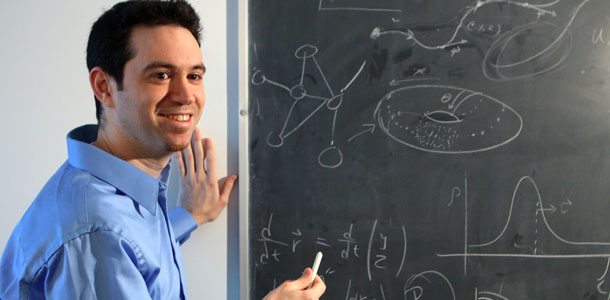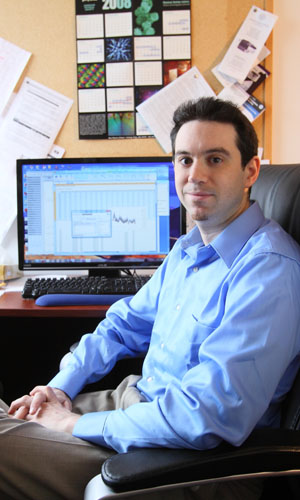Faculty Profile: Danny Abrams Uses Math to Explain Human Behavior

Danny Abrams readily admits it.
“My research is all over the place,” he says. Fireflies. Obesity. Language. Religion. They’re all connected by how Abrams views the world: as a series of phenomena that can be explained with similar mathematical tools.
Now, back from a four-month Fulbright fellowship in Peru and armed with a grant from the James S. McDonnell Foundation, Abrams, assistant professor of engineering sciences and applied mathematics, is using his expertise in synchronization and the physics of social systems to tackle questions of how things work, and why.
Predicting how groups will behave
His interest in applied mathematics was cultivated during graduate school at Cornell, where he began his work in the area of coupled oscillators (the study of how oscillators, like pendulums, behave in groups). An example of this phenomenon can be found in groups of fireflies: in Southeast Asia, groups of fireflies that blink randomly can suddenly begin to blink in synchronization.
"If you have a surface covered with fireflies, you can get in certain situations where a portion of those fireflies blink randomly, while the rest form a spiral-shaped wave of synchronized blinking,” he says. “It’s a new type of pattern formation.”
Abrams created a model of this wave, which has implications outside of insect biology. In humans with certain kinds of heart defects, the cardiac cells around the heart don’t expand and contract in time with the heartbeat. Instead, the cells contract randomly or in a spiral wave that rotates around the heart. Abrams’ model could help explain just how that works.
Synchronization was a factor in a completely different problem that Abrams worked on in graduate school: the opening and subsequent re-engineering of the Millennium Bridge in London. When the bridge first opened in 2000, a crowd of revelers began to cross, and the bridge began to shake side-to-side. The bridge’s contractions forced everyone to fall into the same side-to-side steps, like penguins, which amplified the shaking.
“Here we had a model of people acting like oscillators,” Abrams says. “On this bridge, this natural cycle connects people and made them adapt their footfalls. I’m trying to find examples like this of social systems where you can make mathematical models that can be somewhat predictive or have potential to pinpoint the way a system of humans behave.”
Using math to model the death of languages
Perhaps the social system that most interests Danny Abrams is language: he speaks five (English, Spanish, Quechua, Serbo-Croatian, and Korean) and says it offers a break from his everyday research.
“It’s nice to do something different, not do math and physics all the time,” he says.
But now, he’s combined his hobby with his research to study the phenomenon of language death. There are more than 6,000 languages in the world today, but most of them will die with people who are currently alive. So why are so many languages death-bound? Increased contact between cultures, and a greater ability to travel and communicate across language lines, many say. But Abrams is interested in dual-language cultures, where there is generally a minority language and a majority language — and where, as a model that Abrams created shows, only one can survive.
“My model of competition between languages treats them as though they are trying to compete for speakers,” Abrams says. “It shows that there is a tipping point where the system goes to eventually one language. I think it gives some insight to why this is happening all over the world.”
Abrams recently traveled to Cusco, Peru, for four months to research language death firsthand. Abrams studied Spanish in college and learned Quechua, an Incan language primarily spoken in the Andes, in graduate school after being recruited by a professor who stood outside his Spanish class and asked him, “Want to learn Quechua?” Most Peruvians (about 83 percent) speak Spanish as their primary language, but many, about 13 percent, primarily speak Quechua.
While at the Universidad Nacional de San Antonio Abad del Cusco teaching a course in nonlinear dynamics, Abrams surveyed his students about which language they spoke, which language their parents spoke, and what fraction of their hometown speaks Quechua and Spanish.
“I wanted data about how people’s social networks affect their probability of changing languages,” he says.
Though Quechua isn’t in danger of dying anytime soon, it does make a good case for a model. Studies have shown that two factors drive language change: the majority effect, in which people have an advantage if they can communication with more of their peers (and therefore have an advantage of switching to a majority language), and the status effect, in which society provides greater benefits to those who speak a language that has a higher status. In Peru and much of South America, Spanish is regarded as an urban, higher-class language, while Quechua is mostly spoken in poorer, rural areas. Abrams is using his survey data as a starting point and hopes to conduct a wider survey that will help him expand his model of language death to include social networks.
More models of competition: religion shifts and obesity rates
 Abrams recently received a $279,000, three-year grant from the James S. McDonnell foundation, which funds complex systems research. Using this money, Abrams hopes to study more systems involving two groups competing for members.
Abrams recently received a $279,000, three-year grant from the James S. McDonnell foundation, which funds complex systems research. Using this money, Abrams hopes to study more systems involving two groups competing for members.
One of those systems divides people into two groups: those who are religious, and those who don’t affiliate themselves with any religion. The 2008 American Religious Identification Survey found that Americans who don’t identify with any particular religious group are the fastest growing religious minority. In the Netherlands, those who affiliate with a religion are now in the minority. Using census records from nine different countries, Abrams is working on a model of competition between religious and non-religious groups. Using his language death model as a basis, he has gotten preliminary results that can show just how religious affiliation shifts.
Another system Abrams is studying divides the population into two groups according to weight: obese, and not obese. Obesity rates in the United States have increased to 30 percent over the past 20 years, and recent studies show that the chance of an individual becoming obese strongly correlates with obesity rates of those in their social network. Abrams hopes to create a model that shoes how biological and social factors affect the way people’s weights change over time.
Abrams also hopes to create a model that helps answer why 10 percent of the population is left-handed. Abrams believe it’s an indication of the balance between cooperation and competition in human evolution: if societies were entirely cooperative, everyone would be same-handed. But if competition were more important, one could expect the population to be 50-50. Lefties compose up to 50 percent of top boxers and baseball players, where being left-handed is a key competitive advantage. Abrams hopes to create a model that shows the competition between two groups and how competition and conformity compete to create the 10/90 percent balance.
“As computers and simulation become more widespread in science, it remains important to create understandable mathematical models of the phenomena that interest us,” Abrams said. “By discarding unnecessary elements, these simple models can give us insight into the most important aspects of a problem, sometimes even shedding light on things (like human behavior) that are seemingly outside the domain of math.”